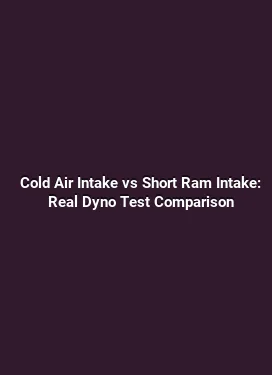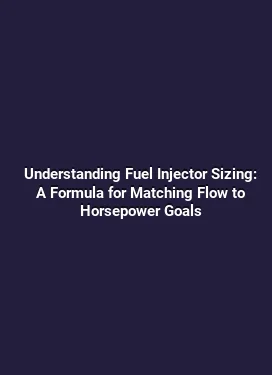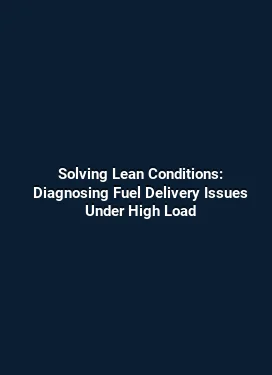Best High Flow Air Filters: K&N vs AEM Dryflow vs Foam Comparison
In modern intake and fueling setups, the air filter plays a critical role in delivering clean, cool air to the engine. Picking the right high flow air filter can influence throttle response, power delivery, and service life. This guide delves into three popular categories: K&N high flow cotton gauze filters, AEM Dryflow filters, and foam-based options. By looking at filtration efficiency, airflow characteristics, maintenance needs, and practical use cases, enthusiasts can make an informed choice that fits both daily driving and track days.
Makale içindeki ilk H2 başlık buraya gelmeli

Understanding High Flow Air Filters and Their Design Philosophy

High flow air filters are engineered to maximize airflow while maintaining a level of filtration that protects the engine from dust and debris. The core idea is to strike a balance: opening the path for air without compromising the quality of what enters the combustion chamber. In many setups, the intake path—from the air intake to the throttle body or manifold—can present bottlenecks. A well-chosen high flow element reduces resistance and helps the engine breathe more freely, especially at higher RPM where air demand climbs rapidly.
Filtration media play a significant role in how a filter handles contaminants. Cotton gauze media, when properly treated and layered, can offer a combination of strong filtration and high surface area. Foam elements rely on a dense, open-cell structure to trap particles while directing air. Synthetic materials can provide consistent performance across temperatures and conditions. Each approach has its own maintenance cadence and long-term behavior under real-world driving.
Evaluating Filtration Efficiency and Airflow
Filtration efficiency is not only about capturing dust but also about maintaining a stable air intake rate. A filter that filters too aggressively can create extra resistance, potentially reducing peak horsepower and throttle response. Conversely, a filter with too little filtration may let abrasive particles reach the engine, which can accelerate wear, especially in dusty environments. The best choice respects the specific operating envelope of the vehicle and the expected driving conditions. Measuring dynamic air flow often involves controlled testing, but practical evaluation comes from observed throttle response, sustained power delivery, and how the intake system behaves during sustained pulls or off-idle acceleration.
First H2 Heading in the Article
K&N High Flow Cotton Gauze Filters: Performance, Reusability, and Real-World Tradeoffs
K&N is renowned for its washable, reusable cotton gauze filters. The media is layered to create a large surface area, which helps reduce flow restriction as the filter loads with dust over time. In daily use, many owners appreciate the opportunity to clean and oil the element instead of replacing it. The cleaning cycle typically involves a degreasing step, rinsing, drying, and re-oiling to restore the protective layer. The longevity of these filters can be impressive when maintenance is consistent, often spanning tens of thousands of miles between major overhauls depending on driving conditions.
From a performance standpoint, K&N filters tend to offer strong sustained airflow gains in comparison to stock paper elements. This translates into a more responsive throttle and a slight uptick in mid-range torque in some applications. However, the gains are highly dependent on the entire intake system, including tubing diameter, piping bends, and the mass air flow sensor (if present). Some owners report a perceived peak power increase on dyno runs, but real-world gains for daily drivers are typically modest and most noticeable in higher RPM ranges or under heavy load. Maintenance discipline is essential; improper oiling or over-oiling can lead to dirt saturation and reduced filtration efficiency.
AEM Dryflow Filters: Simplicity, Dry Media, and Consistency
AEM Dryflow filters utilize a dry, pleated filtration media designed to resist oil-related performance variability. The absence of oil simplifies maintenance and reduces the risk of oil fouling downstream sensors or intake components. These filters are often praised for their straightforward installation and predictable behavior in a wide range of temperatures and altitudes. In terms of airflow, Dryflow units can deliver strong performance in many setups, especially when paired with a properly engineered intake tube and a clean, unobstructed airflow path.
One notable advantage of Dryflow is consistent performance across climates where oil-based filters might experience variances due to moisture or oil distribution. The trade-offs can include a slightly higher initial restriction compared to some oiled cotton configurations, but the maintenance simplicity and reliability can be appealing for street-driven cars and budget builds. As with any filter, ensuring a proper seal and avoiding re-entrant corners in the intake path will help maximize the effective flow area and minimize turbulence.
Foam High Flow Options: Absorption, Filtration, and Durability
Foam filters rely on a dense, porous foam matrix that traps particles while promoting good airflow. They are known for robustness in demanding environments and can tolerate a wide range of operating temperatures. Foam filters often require oiling or conditioning designed for the specific foam type to optimize filtration performance and maintain adequate efficiency over time. The advantage of foam is their ability to maintain flexibility and structural integrity even when exposed to heat or vibration, which can be beneficial on off-road applications or older engine bays with rougher engine movement.
Performance expectations with foam are nuanced. While they can offer strong real-world air delivery, they sometimes lag behind modern oiled cotton or dry media in peak flow under certain conditions. The maintenance schedule typically involves periodic cleaning and re-oiling, with attention paid to ensuring the foam does not become overly saturated. In hot climates or dusty trails, foam can deliver consistent results with proper care, but it may require more frequent attention compared to other media types.
Airflow, Filtration, and Practical Takeaways for Everyday Driving
Choosing among K&N, AEM Dryflow, and foam hinges on understanding how each option behaves in real-world use. For daily commuters, a filter that balances smooth airflow with reliable filtration can translate to noticeable throttle response without sacrificing engine protection. In performance-oriented applications, the emphasis shifts toward maximizing air delivery under high RPM while maintaining sane maintenance intervals and ensuring that the entire intake system supports the increased flow.
Maintenance routines play a pivotal role in sustaining performance. Cotton gauze filters require cleaning, re-oiling, and periodic inspection to ensure no oil bypass or clogging occurs. Dryflow filters demand less maintenance in terms of oiling but still require periodic inspection and cleaning of the pleats to prevent dust buildup. Foam filters need conditioning oil and careful cleaning to preserve foam integrity. A clean, well-sealed system reduces the risk of unfiltered air bypassing the filter—an issue that can negate all the benefits of a high flow element.
Real-World Scenarios: When to Choose Each Option
- Daily drivers in moderate climates: AEM Dryflow or well-maintained K&N filters offer a good balance of performance and ease of maintenance.
- Hot and dusty environments: Foam filters can maintain flow with proper conditioning, though more frequent checks are advised.
- Track days or high-RPM testing: A properly tuned intake that minimizes turbulence and maximizes surface area tends to deliver the most consistent power output, often favoring high flow cotton media with a carefully designed intake tract.
- Budget-conscious builds: Dryflow options may present the most straightforward path to reliable gains with simple maintenance routines.
Another Focus Area: Synergy with the Intake System and Fuel Delivery
The air filter is only one piece of the equation. The intake tract, including the tubing diameter, bends, and the velocity of the air entering the throttle body or intake manifold, works in concert with the filter media. A filter that breathes well but is installed in a restrictive duct will not achieve the full potential of the upgrade. Likewise, a filter that allows too much dust can escalate engine wear over time. Fuel system considerations—such as injector sizing, fuel pressure, and spark timing integrity—also influence how much of the potential gain translates into actual power and driveability.
For performance-minded builds, pairing a high flow filter with a matched intake tube length and cross-sectional area that minimizes sharp bends can yield smoother airflow and reduced intake pulsations. This approach reduces sound-relevant turbulence and helps sustain power across the RPM spectrum. Conversely, a misaligned combination can result in a net loss in throttle response or a laggy feeling at mid-range RPMs, even if the filter itself is capable of higher airflow.
Maintenance Cadence and Longevity Considerations
The life expectancy of a high flow filter is highly dependent on operating conditions. In urban settings with moderate traffic, a well-maintained filter can last longer than in dirt-heavy or high-dust environments. Cleaning intervals for cotton gauze may range from every 10,000 to 20,000 miles, depending on climate and driving style. Dryflow filters typically require inspections and occasional vacuuming or light cleaning but can often stretch longer between intensive maintenance sessions. Foam elements may demand more frequent attention, with oiling and cleaning cycles aligned to the manufacturers’ recommendations and the environment in which the vehicle operates.
Key Takeaways for Selecting a High Flow Filter
Engineers and car enthusiasts often seek a filter that provides a balance of efficiency, durability, and ease of use. The decision should consider climate, driving habits, vehicle type, and the overall intake design. It is prudent to assess the total pressure drop across the system at various engine loads to ensure that the chosen filter does not introduce unintended restrictions during acceleration or sustained high-speed driving. Practical field testing—such as monitoring throttle response, intake whistle, and any changes in power delivery—can help confirm the expected gains. In many setups, the difference between brands can be modest, but the reliability and maintenance profile of the chosen filter can yield more meaningful long-term benefits than marginal peak power increases alone. Frequently Asked Questions






